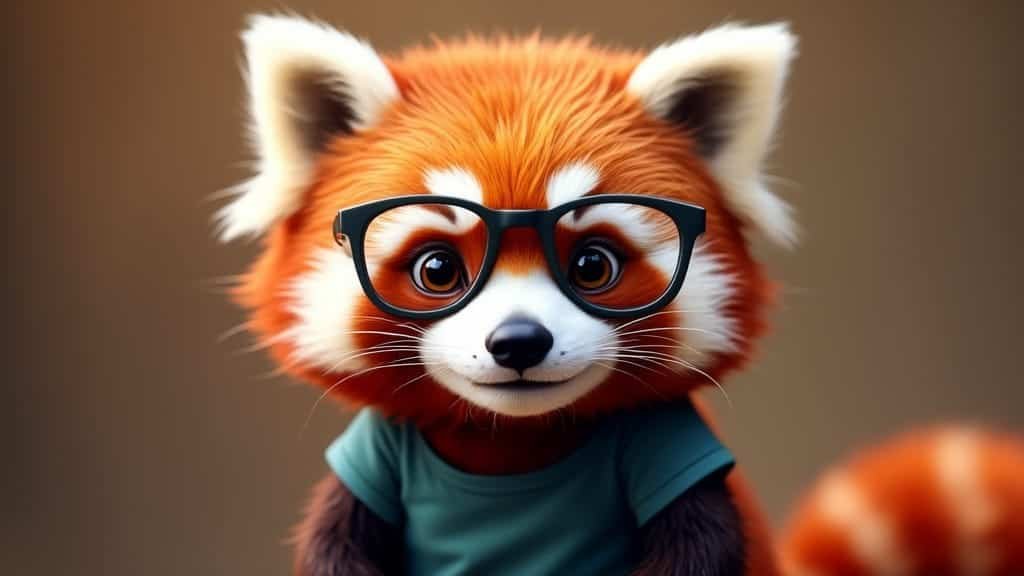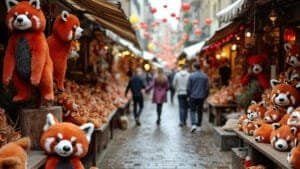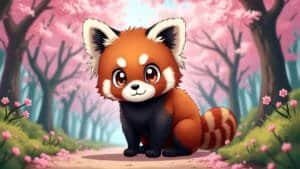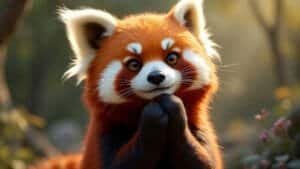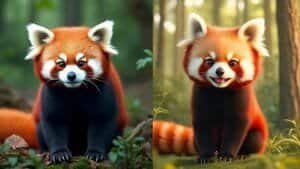Introduction
Red pandas have charmed audiences worldwide, and their popularity has only grown thanks to their starring roles in animation. Known for their fluffy tails, round faces, and endearing personalities, red pandas are a natural fit for animated characters that blend cuteness with quirky humor
From Mei’s transformational journey in Turning Red to Panda’s relatable struggles in We Bare Bears, these animated characters have captured the hearts of both children and adults alike
This article explores some of the most beloved red panda characters in animation, examining their roles, personalities, and how they reflect the traits of real-life red pandas
Mei from Turning Red
Mei Lee, the central character of Disney and Pixar’s Turning Red, is one of the most popular animated characters inspired by a red panda
The movie, released in 2022, follows Mei, a 13-year-old Chinese-Canadian girl who discovers that she has a unique family curse: whenever she experiences intense emotions, she transforms into a giant red panda
This transformation serves as a metaphor for the challenges of adolescence, including the complex emotions, identity shifts, and changes that come with growing up
Mei’s Transformation into a Red Panda
Mei’s transformation into a red panda is a key plot point in Turning Red. Every time she gets overly excited, angry, or stressed, she turns into a large, fluffy red panda. The transformation is uncontrollable at first, leading to humorous yet challenging situations as she navigates school, friendships, and her family life while trying to keep her red panda side hidden
The red panda transformation is not only a source of humor but also represents the emotional turbulence that many teenagers experience
The physical changes Mei undergoes mirror the metaphorical transformations that happen during puberty, with the red panda symbolizing the uncontrollable feelings and changes that come with this stage of life. Over the course of the movie, Mei learns to embrace her red panda side, symbolizing self-acceptance and growth
Symbolism of Red Pandas in Turning Red
In Turning Red, the red panda symbolizes more than just the chaos of adolescence. It also represents the cultural heritage Mei’s family has carried for generations. The movie explores the theme of balancing personal identity with family expectations, as Mei’s family has a deep connection to the red panda transformation
In the story, the red panda represents a powerful and protective spirit that the women in Mei’s family have inherited, but it has also become something they must control or hide
The movie touches on cultural themes as well, particularly the intersection of Chinese traditions and modern North American life. Mei’s struggle to embrace her red panda side reflects her journey to balance the expectations of her traditional family with her own desires and independence
The red panda thus becomes a symbol of heritage, family, and the inner conflict many people experience when trying to reconcile cultural identities
Mei’s Popularity and Cultural Impact
Mei’s character and her connection to the red panda quickly resonated with audiences, making her one of the most beloved red panda-inspired characters in animation
Her transformation into a red panda, which is both humorous and relatable, struck a chord with young viewers going through similar experiences of growing up and dealing with emotional changes. The film’s vibrant animation, engaging storyline, and culturally diverse representation contributed to its success, with Mei becoming a positive symbol of self-discovery and acceptance
Mei’s giant red panda form has also become iconic, with merchandise, fan art, and social media discussions celebrating her character. The film’s success helped to introduce red pandas to an even wider audience, raising awareness about the real-life endangered species while providing a positive and empowering message for young viewers
Research by Anderson (2020) discusses how Turning Red successfully uses the red panda as a metaphor for the emotional complexities of adolescence, noting that the film’s visual representation of Mei’s transformation captures both the humor and seriousness of growing up
Mei’s character has become a cultural icon, reflecting themes of identity, family, and the struggles of adolescence in a relatable and entertaining way
Panda from We Bare Bears
Panda, or simply “Pan-Pan,” is one of the main characters from the animated series We Bare Bears, created by Daniel Chong and aired on Cartoon Network
As a character based on a red panda, Panda stands out with his soft-spoken, sensitive, and tech-savvy personality. He’s one of the three anthropomorphized bear brothers—Grizzly, Ice Bear, and Panda—who navigate life in the modern world, often dealing with themes of friendship, identity, and social anxiety
Panda’s Role in We Bare Bears
Panda serves as the middle brother in We Bare Bears and is portrayed as the most emotional and sensitive of the trio. Unlike the confident and outgoing Grizzly, Panda is shy, often anxious, and very much in tune with modern technology
He is frequently seen using his phone, taking selfies, and interacting with social media, which adds a humorous commentary on modern digital culture
Panda’s role in the series is not just to provide comic relief but also to explore deeper issues related to self-image, insecurity, and the desire for connection. As a red panda, Panda’s naturally cute and fluffy appearance complements his soft personality, and he is often portrayed as the more vulnerable and empathetic member of the group
Despite his insecurities, Panda shows loyalty and care toward his brothers and often finds himself in humorous yet heartwarming situations where his gentle nature shines through
His interactions with his brothers highlight the strong bond between them, and his character development throughout the series focuses on overcoming his anxieties and embracing his own strengths
How Panda’s Personality Reflects Red Panda Traits
Panda’s personality in We Bare Bears is closely aligned with the traits associated with real-life red pandas
Red pandas are known for being solitary, shy, and somewhat elusive animals, and these characteristics are reflected in Panda’s introverted and sensitive nature. While his brothers are more adventurous and daring, Panda often prefers to avoid conflict, showing a preference for peace and harmony
Panda’s love for technology and social media, while a humorous modern twist, reflects his desire for connection and validation, which parallels the real-life behavior of red pandas, who communicate through scent marking and other subtle cues. This trait of seeking communication, even if indirectly, mirrors Panda’s desire for social acceptance and emotional support
Additionally, Panda’s physical characteristics in the show—his round face, expressive eyes, and fluffy fur—make him especially endearing, much like the real red panda, which is celebrated for its adorable appearance
This cuteness is often used to humorous effect in the series, as Panda is acutely aware of his charm and tries to use it to his advantage, particularly when trying to impress others or gain attention
Why Panda Became a Fan Favorite Character
Panda quickly became a fan favorite in We Bare Bears due to his relatable personality and the humor derived from his socially awkward and tech-savvy tendencies. His struggles with self-confidence, anxiety, and fitting in resonate with many viewers, particularly younger audiences who face similar challenges in navigating friendships and social situations
Panda’s vulnerability and emotional depth make him a relatable character, and his journey toward self-acceptance is a central theme that many fans appreciate
Panda’s cuteness and gentle demeanor also contribute to his popularity. As a red panda, his character design is visually appealing, and his soft, approachable nature makes him an easy character to root for
Throughout the series, Panda’s growth—from a nervous, insecure bear to one who learns to trust himself and his brothers—adds depth to his character and further endears him to audiences
The success of We Bare Bears has led to widespread merchandising and fan engagement, with Panda being one of the most recognizable characters from the show. His appeal crosses generational lines, as both children and adults relate to his humor, charm, and emotional complexity
The show’s portrayal of modern life, combined with its endearing characters, has made We Bare Bears a beloved series, with Panda playing a central role in its success
Research by Hutchins and James (2015) on animal representation in popular culture highlights how anthropomorphized characters like Panda resonate with audiences by blending human emotions with animal traits. The study notes that Panda’s character strikes a balance between humor and relatability, making him a standout figure in animated television
Other Popular Red Panda Characters in Animation
Beyond Mei from Turning Red and Panda from We Bare Bears, several other red panda characters have appeared in animated media, showcasing the animal’s widespread appeal in various cultural contexts
These characters range from lighthearted and cute to more complex, embodying the red panda’s traits of charm, shyness, and even fierceness. Among them, Aggretsuko’s Retsuko stands out as one of the most recognizable red panda characters in Japanese animation, while other red pandas have made appearances in various animated TV shows and movies
Retsuko from Aggretsuko: The Angry Red Panda
Retsuko, the main character of Aggretsuko, is one of the most popular red panda characters in Japanese animation
Created by Sanrio, the same company behind Hello Kitty, Aggretsuko follows the life of Retsuko, a 25-year-old red panda who works a monotonous office job and deals with the frustrations of daily life. While Retsuko appears to be a mild-mannered and polite employee, she harbors a secret: she vents her rage through death metal karaoke sessions after work
Retsuko’s double life reflects the pressures and frustrations many people experience in their daily lives, especially in the context of Japanese office culture. Her red panda form makes her cute and relatable, but her explosive, death-metal outbursts reveal the emotional depth beneath her seemingly calm exterior
The juxtaposition of her adorable appearance and fierce inner world has made Aggretsuko a hit among both younger and older audiences, as it tackles themes like stress, workplace struggles, and finding one’s voice
Retsuko’s red panda identity is symbolic, as red pandas in the wild are often shy and solitary, much like how Retsuko feels isolated in her daily life. However, through her journey in the series, she learns to express herself and connect with others, finding a balance between her outer and inner worlds
Aggretsuko’s popularity has spread globally, with Retsuko becoming an iconic character in modern Japanese animation, known for her relatable struggles and humorous take on office life
Red Pandas in Animated Movies and TV Shows
Red pandas have also appeared in various animated movies and TV shows, often playing supporting or minor roles but still leaving a memorable impact due to their unique appearance and personality
For instance, red pandas make cameo appearances in shows like Kung Fu Panda: Legends of Awesomeness, where they are depicted as cute, curious animals that add a touch of humor to the scenes they appear in
In the Disney series The Lion Guard, a red panda character named Pinguino briefly appears in an episode, again showcasing the animal’s growing popularity in children’s animated content. Red pandas are often depicted as cute and playful, appealing to younger audiences, and their visual design in these shows highlights their distinct, fluffy tails and expressive faces, making them stand out
In movies, red pandas have also made small appearances, often used for comic relief or to represent nature and balance due to their gentle, peaceful demeanor. While these roles are usually minor, the presence of red pandas in animated media reflects the growing awareness and affection for the species
How Red Panda Characters Appeal to Both Kids and Adults
The appeal of red panda characters in animation lies in their ability to resonate with both children and adults. Children are naturally drawn to the red panda’s cute and fluffy appearance, while adults often connect with the deeper, more relatable themes these characters explore
For example, Retsuko from Aggretsuko embodies the stress and frustration of adult life, using her red panda identity to symbolize the hidden emotions many people feel but cannot express openly
Similarly, Mei from Turning Red speaks to both children and parents, as her transformation into a red panda reflects the universal experience of growing up, with all the emotional ups and downs that come with adolescence
Panda from We Bare Bears offers a more lighthearted approach, appealing to kids with his gentle, introverted personality, while also connecting with adults through his social anxieties and humorous take on modern life
Red pandas in animation often embody innocence, humor, and a sense of mischief, making them versatile characters that can carry emotional weight while still providing comedic relief. Their natural traits—shyness, cuteness, and curiosity—lend themselves well to storytelling, and animators use these characteristics to create lovable, memorable characters that resonate across generations
Research by Liu (2019) discusses how red pandas are increasingly used in media as symbols of both innocence and depth, appealing to a wide audience. The study found that red panda characters are often used to explore themes of self-discovery, emotional expression, and balance, making them ideal for both children’s stories and more mature narratives
The Appeal of Red Pandas in Animation
Red pandas have a unique charm that has made them increasingly popular in animated media. Their natural characteristics—cuteness, shyness, and playfulness—translate well into animated characters that captivate audiences of all ages
These qualities, combined with the emotional depth that many red panda characters embody, make them versatile figures in storytelling. The appeal of red pandas in animation lies in their ability to evoke empathy, humor, and a sense of innocence, while also reflecting more complex human emotions and experiences
How Animators Use Red Pandas’ Natural Traits
The physical appearance of red pandas makes them ideal for animated characters. With their fluffy tails, round faces, and expressive eyes, red pandas are visually appealing, which animators enhance by exaggerating these features
For instance, characters like Mei from Turning Red and Panda from We Bare Bears are designed to emphasize their cuteness and soft appearance, making them immediately endearing to audiences
Animators also highlight the red panda’s natural behaviors, such as climbing, curling up into balls, and their gentle movements, to make their characters more relatable. In Turning Red, Mei’s red panda form is large, fluffy, and a little clumsy, capturing both the humor and awkwardness of her transformation
Panda from We Bare Bears also reflects the gentle and introverted nature of real red pandas, as his character is shy and often retreats to his phone or his brothers for comfort
These natural traits make red pandas ideal for creating characters that are cute and lovable, but also complex enough to carry emotional weight. Whether used for comic relief or more serious storylines, red panda characters are often positioned as gentle and non-threatening, which helps audiences form an instant emotional connection with them
The Emotional Connection Between Red Panda Characters and Audiences
Red pandas in animation not only appeal visually but also resonate on an emotional level. Many red panda characters are portrayed as sensitive, introverted, or misunderstood, making them relatable to audiences who identify with these traits
Characters like Retsuko in Aggretsuko and Panda in We Bare Bears are beloved because they represent the struggles of dealing with anxiety, social pressures, and self-acceptance, topics that resonate strongly with both children and adults
Retsuko’s dual nature—cute and soft on the outside but harboring intense emotions—mirrors the way many people suppress their feelings in real life. Her red panda identity amplifies this dynamic, symbolizing the contrast between her calm, quiet demeanor and the intense anger she expresses through her death metal performances
This emotional depth allows audiences to connect with her on a personal level, turning her into a symbol of resilience and self-expression
Similarly, Mei’s red panda transformation in Turning Red reflects the emotional turbulence of adolescence, making her journey toward self-acceptance something that viewers can relate to, especially those who have experienced similar struggles with identity and personal growth
The red panda form allows these emotions to be externalized, giving them a visual and narrative impact that makes Mei’s story more engaging and accessible
Research by Anderson (2020) highlights how red panda characters in animation are often used to symbolize vulnerability, personal growth, and the challenges of self-discovery. These emotional connections make red panda characters more than just cute figures—they become vehicles for exploring deeper themes and human experiences
Red Pandas as Symbols of Innocence, Humor, and Mischief
In addition to their emotional appeal, red pandas are often used as symbols of innocence, humor, and mischief in animated media. Their naturally shy and curious demeanor lends itself well to creating characters that are both playful and endearing
For instance, in shows like We Bare Bears, Panda’s socially awkward but good-hearted personality often leads to humorous situations, while his cuteness makes these moments even more charming
Red panda characters can also embody a sense of mischief and playfulness, as seen in Turning Red, where Mei’s red panda form leads to chaos and comic misunderstandings as she tries to control her transformations
The mix of innocence and mischief allows red panda characters to add a light-hearted, fun element to animated stories, appealing to younger audiences while still being entertaining for adults
In Japanese animation, red pandas are often depicted with a balance of cuteness and depth. Retsuko’s cute appearance is juxtaposed with her intense, rebellious side, creating a humorous contrast that has helped her character gain widespread popularity. This balance of innocence and emotional complexity allows red pandas to serve as versatile characters in both comedic and dramatic contexts
The combination of innocence, humor, and mischief makes red panda characters memorable and beloved. Their visual appeal, combined with the depth of their emotional narratives, allows animators to create characters that can switch between light-hearted humor and deeper, more meaningful storytelling
Research by Miller (2016) found that animated red panda characters often embody a balance of humor and relatability, making them highly engaging for audiences. The study emphasized how red pandas’ natural traits contribute to their versatility in animation, allowing them to carry a wide range of emotions and themes in storytelling
Conclusion
Red pandas have found a unique place in the world of animation, captivating audiences with their charming mix of cuteness, playfulness, and emotional depth
Characters like Mei from Turning Red, Panda from We Bare Bears, and Retsuko from Aggretsuko have become iconic, each offering something different yet equally relatable to viewers. Whether used to explore themes of adolescence, social anxiety, or workplace frustrations, these red panda characters symbolize innocence, vulnerability, and self-discovery, making them both humorous and deeply meaningful
Animators capitalize on the natural traits of red pandas—their fluffy appearance, gentle nature, and curious behavior—to create characters that appeal to both children and adults
Their versatility in storytelling allows red pandas to shine in various roles, from comedic sidekicks to emotionally complex protagonists, and they often serve as a reflection of real-life struggles with identity, personal growth, and emotional expression
The growing popularity of red panda characters in animation also brings attention to the real-life species, highlighting the unique traits of red pandas and, in some cases, raising awareness about the conservation of this endangered animal. As more animated content continues to feature red pandas, their presence in pop culture will likely continue to inspire and resonate with audiences worldwide
